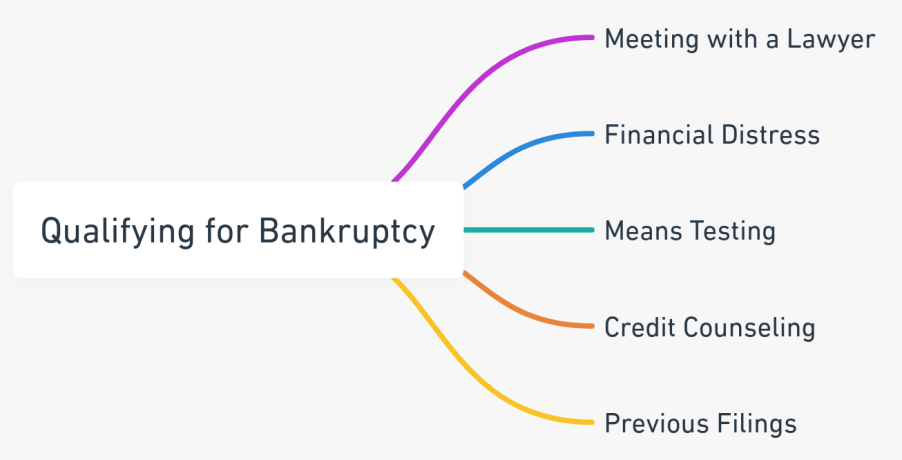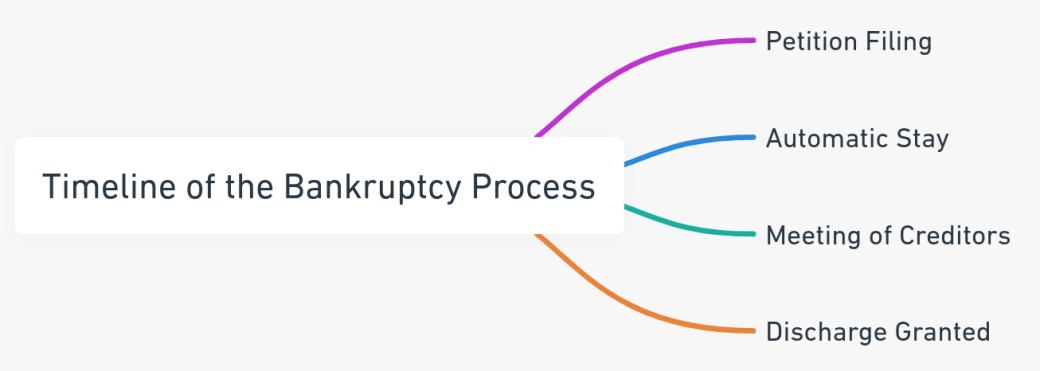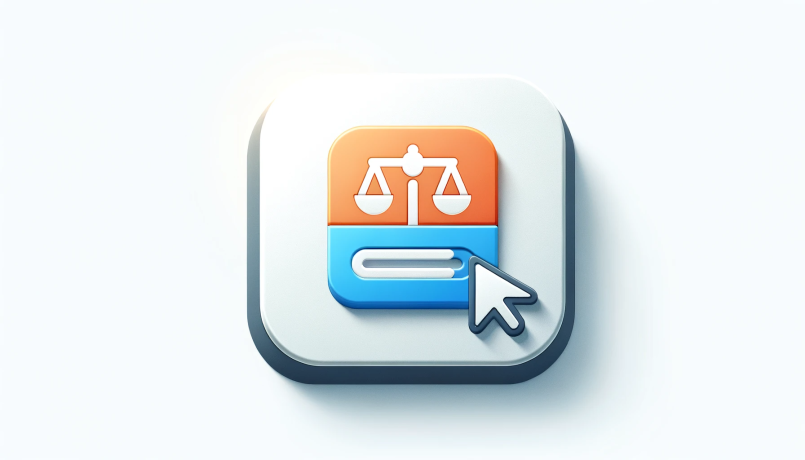
Filing for bankruptcy is a significant step for those facing severe financial challenges. This guide offers an overview of the process, from qualifying to rebuilding credit, providing a lifeline for individuals seeking a fresh financial start.
by LawInc Staff
November 19, 2023
Filing for bankruptcy can be a difficult but necessary step for individuals facing severe financial distress. With close to 500,000 bankruptcy cases filed each year in the U.S., it’s clear this option remains relevant for many people seeking debt relief and a fresh financial start.
Understanding the bankruptcy process is crucial when evaluating if it’s the right choice for your situation. This guide covers key factors to consider when filing bankruptcy.
1. Qualifying for Bankruptcy

Essential Criteria for Bankruptcy Qualification
-
- Financial Distress: Individuals typically qualify if unable to pay debts and facing hardship like wage garnishment or foreclosure.
- Means Testing: Applies to Chapter 7; compares income to state median; high earners may be required to file Chapter 13 instead.
- Credit Counseling: Must receive credit counseling 180 days before filing; proves bankruptcy as last resort.
- Previous Filings: Restrictions exist on how often you can file; varies by chapter.
Example: Dan’s Bankruptcy Qualification
-
- Dan lost his job and was unable to pay his debts.
- He qualified for Chapter 7 based on means testing.
- Completed credit counseling 6 months prior.
Tips on Qualifying for Bankruptcy
-
- Consult a bankruptcy attorney to assess eligibility.
- Calculate income and expenses to determine financial state.
- Research filing restrictions based on previous bankruptcy cases.
Frequently Asked Questions
-
- What are common signs someone may qualify for bankruptcy? Struggling to pay bills, creditor harassment, wage garnishment, home foreclosure threat.
- Do income limits apply for Chapter 7 bankruptcy? Yes, means testing compares income to state median; higher earners file Chapter 13.
- How soon after credit counseling can you file bankruptcy? Bankruptcy filing must be at least 180 days after counseling session.
2. Chapters of Bankruptcy

Overview of Bankruptcy Chapters: 7, 13, and 11
-
- Chapter 7: Liquidation; eligible assets sold to pay creditors; remaining debts discharged.
- Chapter 13: Debt reorganization; debtor keeps assets; repays creditors through payment plan.
- Chapter 11: Business reorganization; company remains operating while repaying creditors.
Example: Comparing Bankruptcy Chapters
-
- Chapter 7 – Assets liquidated, remaining debts discharged.
- Chapter 13 – Debts reorganized and repaid through payment plan.
- Chapter 11 – Business remains operating while repaying creditors.
Tips on Choosing the Right Chapter
-
- Evaluate assets at risk for liquidation under Chapter 7.
- Assess income stability to determine feasibility of Chapter 13 plan.
- Chapter 11 makes sense if aiming to reorganize and save a business.
Frequently Asked Questions
-
- Can you choose which bankruptcy chapter to file under? Yes, but you must meet eligibility criteria for the specific chapter.
- Do you keep property when filing Chapter 7? Some property is exempt; anything non-exempt may be liquidated.
- How long does the bankruptcy stay on your credit report? Chapter 13 remains for 7 years; Chapter 7 remains for 10 years.
3. Costs to File

Key Expenses in Bankruptcy Filing
-
- Court Filing Fees: Vary by chapter choice; due when petition is filed; Chapter 7 fee is $338.
- Attorney Fees: Average $1,500-$3,000 for less complex filings; higher for complex cases; paid up front or via payment plan.
- Pre-bankruptcy Credit Counseling: Required counseling averages $50-$100 and paid directly to agency.
Example of Bankruptcy Costs
-
- $338 court filing fee for Chapter 7
- $2,500 attorney fees, paid over 12 months
- $75 for pre-filing credit counseling session
Tips on Managing Bankruptcy Costs
-
- Research average attorney fees to set realistic budget.
- Ask about payment plans if unable to pay attorney fee upfront.
- Compare credit counseling agencies for most affordable option.
Frequently Asked Questions
-
- Can you file bankruptcy without an attorney? Possible but not recommended; attorneys navigate process.
- Are there payment plans for attorney fees? Yes, many lawyers offer affordable monthly payment options.
- Can the court filing fee be waived for financial hardship? Yes, you can request a filing fee waiver from the court.
4. Meeting of Creditors

Key Elements of the Bankruptcy Creditors’ Meeting
-
- Attendance Required: Debtor must attend; failure to appear can lead to case dismissal.
- Under Oath: Debtor is placed under oath and answers questions about financial affairs.
- Creditor Participation: Creditors can attend and ask questions if desired.
Example Meeting of Creditors Experience
-
- Debtor attended and provided testimony under oath.
- Trustee asked questions about income, assets, debts.
- Few creditors attended or participated.
Tips for the Meeting of Creditors
-
- Review case with attorney to prepare for potential questions.
- Bring required documents like tax returns and pay stubs.
- Listen to trustee carefully and answer questions accurately.
Frequently Asked Questions
-
- Where are meetings of creditors held? Typically at courthouses, federal buildings, or trustee offices.
- What happens if you miss the meeting of creditors? The court may dismiss your bankruptcy case if you fail to appear at the required meeting.
- Can you reschedule the meeting of creditors? Yes, if you have a valid conflict, your attorney can request to reschedule the meeting.
5. Timeline of the Process

Key Stages in the Bankruptcy Filing Timeline
-
- Petition Filing: Case formally begins when bankruptcy petition is filed with court.
- Automatic Stay: Collection against debts is halted upon filing; creditors must cease contact.
- Meeting of Creditors: Held about 30-60 days after filing; debtor questioned under oath.
- Discharge Granted: Court order releasing debtor from liability for dischargeable debts; timing varies.
Example Bankruptcy Timeline
-
- Filed Chapter 7 petition on 1/5/2023
- Automatic stay halted collection immediately
- Meeting of creditors held on 2/15/2023
- Discharge granted on 5/20/2023
Tips on Navigating the Timeline
-
- Stay organized with deadlines for required documents and financial records.
- Notify creditors of automatic stay to halt collections immediately.
- Don’t miss the meeting of creditors or discharge may be denied.
Frequently Asked Questions
-
- How soon after filing is the automatic stay effective? Immediately upon petition filing.
- When does discharge relieve debts? After all required documents submitted and no objections from creditors.
- How long does the bankruptcy process take? Typically 3-6 months until discharge granted.
6. Debts Discharged

Understanding Debt Discharge in Bankruptcy
-
- Elimination of Debt: Discharge provides fresh start by eliminating legal obligation to pay.
- Exceptions Apply: Certain debts like taxes, fines, alimony cannot be discharged.
- Ongoing Liens: Discharge removes personal liability but valid liens remain on property.
Example of Discharged Debts
-
- Credit card balances eliminated
- Medical debts removed
- Mortgage lien remains on property
Tips on Understanding Debt Discharge
-
- Review non-dischargeable debts to avoid surprises.
- Consult attorney on validity of any liens remaining after discharge.
- Keep making payments on reaffirmed debt until paid off.
Frequently Asked Questions
-
- What types of debts are not discharged in bankruptcy? Taxes, student loans, child support, alimony, court fines.
- Is a mortgage eliminated with Chapter 7 bankruptcy? No, the underlying lien remains even when personal liability is discharged.
- Can you voluntarily repay a discharged debt? Yes, you can voluntarily repay debts for moral reasons.
7. Rebuilding Credit After Bankruptcy

Navigating Credit Rebuilding After Bankruptcy
-
- Negative Impact: Bankruptcy damages credit score, especially right after filing.
- Gradual Rebound: Credit score typically rebounds and improves over time.
- Disciplined Habits: On-time payments, low balances, and financial prudence help demonstrate changed behavior.
Example Credit Rebuilding Journey
-
- Score dropped 100 points after filing
- Regained 50 points in 12 months of responsible habits
- Continues making payments on time and keeping balances low
Tips for Rebuilding Credit
-
- Get secured credit card and use responsibly to show positive payment activity.
- Avoid high balances and minimize credit inquiries.
- Check credit reports for errors and file disputes promptly.
Frequently Asked Questions
-
- How long does bankruptcy stay on your credit report? Up to 10 years from filing date.
- How soon can you get a credit card after bankruptcy? Usually within 6-12 months, often starting with secured cards.
- Does the impact of bankruptcy lessen over time? Yes, the negative effect on your credit score decreases as time passes.
Need Help With Bankruptcy Filing?
Contact us to speak with a knowledgeable bankruptcy attorney and if you need guidance on the process and to determine if filing is right for your situation.






